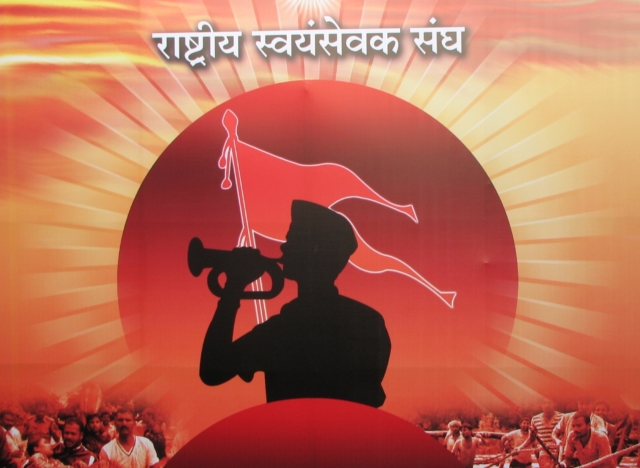Charkha and Sudarshan Chakra;The role of RSS in the freedom struggle

Golda Meir, the first and the only woman prime minister of Israel, said, â€One cannot and must not erase the past merely because it does not fit the present.†This is pertinent to the ongoing national discourse on the apparent lack of participation of the Rashtriya Swayamsevak Sangh (RSS) in the Quit India Movement. It is claimed that RSS workers were cowards who shied away from responsibility during the struggle. But are these accusations based on facts or the usual one-sided historical narrative aimed at negating the ideology of revolutionaries who were not averse to using violence to achieve independence?
Recently, Prime Minister Narendra Modi put it beautifully: Sudarshan Chakradhari Mohan and Charkhadhari Mohan, both need to be celebrated, on dual occasions of Independence Day and Janmashtami. Most Gandhians look distressed when names of firebrand revolutionaries or organisations are mentioned, because the Indian national movement is widely treated as one based on ahimsa. Thus, recalling acts of Bhagat Singh, who sacrificed his life for our motherland at the tender age of 23, is equivalent to blasphemy. What they fail to understand is when the national struggle was stagnating post the Jallianwala Bagh incident and Lala Lajpat Rai’s death, it was Bhagat Singh who infused a renewed vigour through his defiant acts, despite being devoid of political protection.
It was neither the Congress leaders sitting inside prison nor the adherence to ahimsa that the British feared; it was Netaji Subhas Chandra Bose’s persistent efforts to organise the Indian National Army. It was Chandra Sekhar Azad’s decision to choose death over capture, when surrounded by enemies at the Alfred Park, that scared them. Surprisingly, Mahatma Gandhi himself had popularised self-sacrifice by adopting the “Do or Die†slogan.
Then, by what right do we claim that our freedom was won through non-violence? Is it not an insult to the memory of the freedom fighters who bore unspeakable horrors? When the Quit India Movement was launched on August 8, 1942, top Congress leaders were imprisoned within 48 hours. They usually had political protection, which members of nascent organisations like Hindustan Socialist Republican Association and the RSS lacked. And yet, the Delhi sanghchalak Lala Hansraj Gupta provided asylum to leaders like Aruna Asaf Ali and Jayaprakash Narayan. Many swayamsevaks set up a parallel government in the Vidarbha region. Some were sentenced to death.
RSS workers also damaged the Delhi-Muzaffarnagar railway line while others bravely faced bullets trying to unfurl the tricolour atop the tehsil office in Mewan, Meerut. The 1943 intelligence report on RSS stated “the ulterior objective of the RSS is to drive away the British from India and free the countryâ€. But, they did not popularise their acts.
On September 4, 1935, Jawaharlal Nehru was released from Almora jail, five and a half months before his term ended, and left by plane the same day for Europe, to see his ailing wife Kamla Nehru (mentioned in Frank Moraes’s biography Jawaharlal Nehru).
On the other hand, the Savarkar brothers got to meet their family only once in 15 years, while jailed in the Andamans, and in this meeting came to know that their elder brother Babarao’s wife had died earlier. This tale of the neglect of firebrand revolutionaries by their own comrades who could have saved them, lacks mention in history textbooks.
Participants of war must be prepared to shed their blood. I disagree that it was ahimsa alone that initiated our struggle for independence. Our wars were fought by Kittur ki Rani Chenamma, Jhansi ki Rani Lakshmibai and millions of unnamed Indians who took to charkha or swords in equal measure. It was this spark that was reignited by the so-called violent acts of Savarkar and Bhagat Singh which enabled the Indians to weather the long winter of colonial violence and repression. The RSS pledge had the words Desh ko swatantra kar (Free the country) right from the beginning until independence. Even today, principles of swadeshi and gram swaraj are followed by the RSS more than others.
Read More :Â http://www.theweek.in/columns/Meenakashi-Lekhi/charkha-and-sudarshan-chakra.html
Welcome to Haindava Keralam! Register for Free or Login as a privileged HK member to enjoy auto-approval of your comments and to receive periodic updates.
Latest Articles from Bharath Focus
- Narendra Modi: The Architect of India’s Momentous Transformation
- Republic Day Tableaux & Regional Pride
- Tarun Vijay meets Governor Arif Khan on Adi Sankara birthplace
- SC-ST പോസ്റ്റ് മെട്രിക് സ്കോളർഷിപ്പിൽ 5 ഇരട്ടി വർദ്ധനവ്
- Treading the Middle-Path on Temple Management
- Taming the dragon-Part-3
- Taming the dragon- Part 2
- India- China trade wars on the cards? Well researched blog on Indian govt.’s proposed plan to tax 371 Chinese goods
- Before removing the idols, I should be removed; Two Kerala faces we should never forget
- The Unseen Unheard Victims of Article 35(A)

